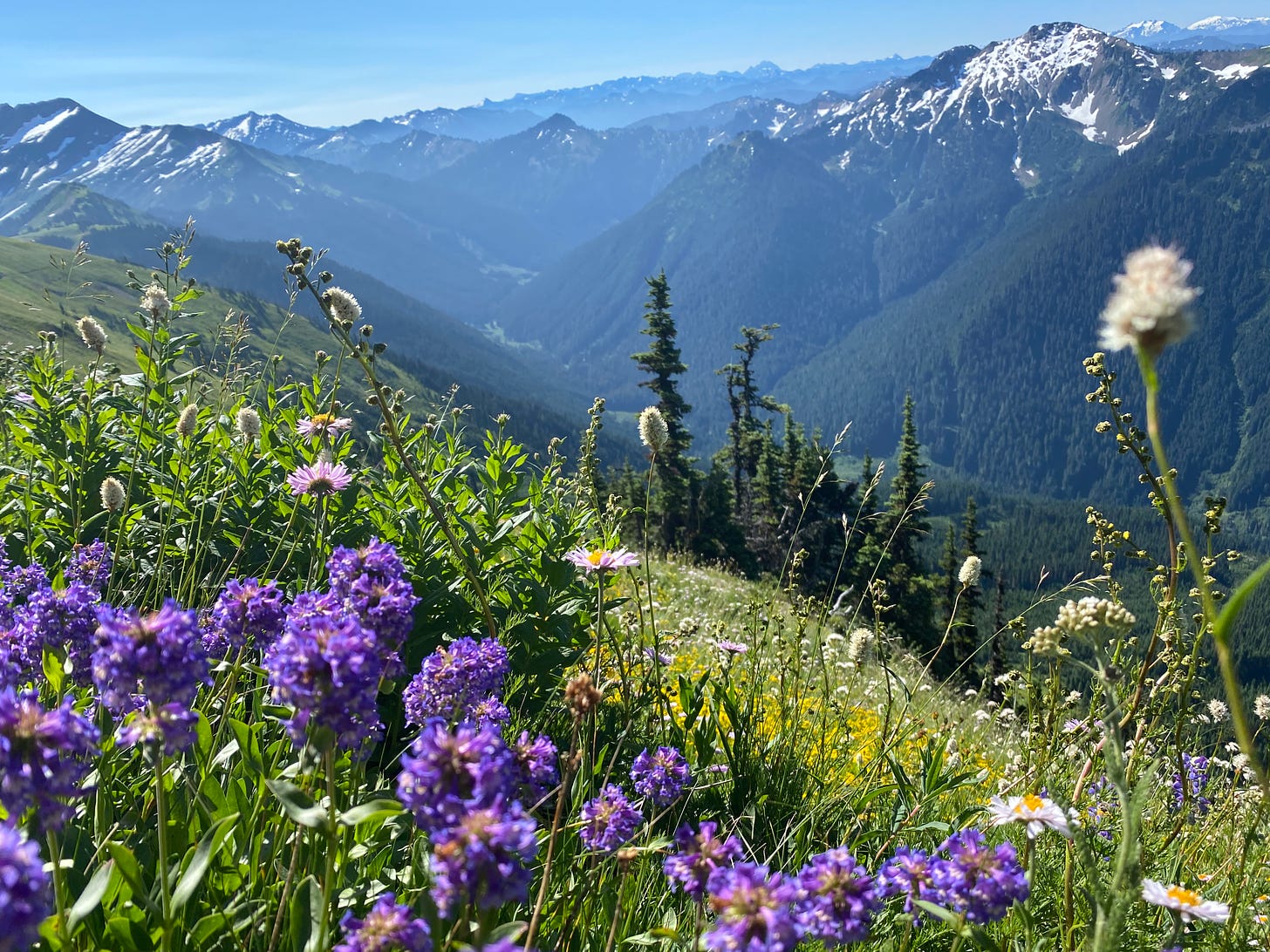
Note: In what some reporters are calling a “huge win” for the Mediocre Community, my book will soon be available for purchase at a brick-and-mortar Seattle-area store called Third Place Books. But if you live elsewhere or are just impatient, you can order it online with the button below, at your own favorite independent bookstore, or on Kindle.
The first six miles of the North Fork Sauk River Trail are, as far as I’m concerned, just about perfect. Towering cedars and Douglas firs whose first branches start out of sight, up above the canopy of younger trees. Lush borders of ferns, punctuated by huckleberry and salmonberry bushes. The river gushing in the dappled sunlight. It is humbling to walk through a place that is so clearly unconcerned with you. A living place that is in constant conversation with itself—redistributing, recalibrating, giving birth, requiring death. A fragrant cedar tree older than the automobile topples, and soon you can see three more of them growing from the bed of moss draped over the fallen trunk. An unseen city of fungus spreads out beneath the forest floor, ready to burst forth new nodes with each new blowdown.
The world is at once more fragile and more durable than we imagine. We should be mindful of the damage we do to it, of course. But we too often imagine ourselves to be the protagonist in a world older and more intricate than we can comprehend.

On our first night, after an easy six miles through that fragrant and peaceful stretch of forest, my friend Will and I made dinner on a little gravel bar caught between bends of the Sauk. All this interconnected liveliness was on display here, too: miniature ecosystems in each and every pool and lazy stretch, fallen trees littering the bar helping cast nutrient-rich detritus into the riffles, kinks and bends of water carving out the banks and so plotting a course for growth and death for ages to come.
We have a lot to learn from the shape of water (not the very good Guillermo del Toro fish guy film). Those valuable bends and kinks are noticeably absent from America’s major rivers—the product of human intervention, a war on nature’s design by the ostensibly noncombatant Army Corps of Engineers. A winding, tumultuous river is bad for business.
The author William Least Heat-Moon talks about this in his travelogue River Horse, which I nicked from my dad’s shelves a few years ago and am now realizing I forgot to return. (Sorry, pops.)
Channelizing destroyed thousands of acres of natural habitats, removed spaces that formerly absorbed high waters to lessen the impact of floods, and forced Americans to pay millions of dollars to benefit a few companies and bottom farmers and people who should never have built houses and businesses in the altered floodplain in the first place.
If that isn’t a microcosm for this whole country I don’t know what is.
Okay, besides this.
Anyway enough depressing shit, back to the beauty.

The nice part about hard hikes, I find, is that they force you to let go of your ordinary troubles and focus on the more immediate difficulties—what the switchbacks are doing to your legs and lungs, the weight of your pack, how much water you have left and how far to the next reliable source. And when those difficulties are overcome what comes rushing in to fill the void where they once sat is not your old troubles, but something like exultation. Will and I got to experience that aplenty in the days following our first leisurely stroll. Our ultimate destination was Glacier Peak Meadows, a gorgeous alpine camping spot that requires hikers to ascend 3,000 vertical feet in three miles of trail to a mountain pass and then descend 1,500 back down the other side.
While you’re working through those immediate difficulties, luckily, you need to rest sporadically (or like every three switchbacks, in my case). This presents an opportunity to view even more clearly the interconnectedness of things, if you live in Washington or someplace similar. On the alpine trails in high summer, wildflowers abound here, improbable blankets bursting with colors that mortal minds probably wouldn’t think to put together: fiery reds and oranges and yellows of castilleja and tiger lily and glacier lily, hills of green grass, cool blues and purples of harebell and daisy and lupine. The shocking pinks of fireweed and Scottish heather. These flowers are watered by the runoff from ages-old glaciers which punctuates the trails of the Cascade range. Thrilling and terrifying to think of how much snow and ice is up there in those basins and bergschrunds, truly.



That we are all connected inextricably to one another and the natural world in which we live is no secret. (Most of the people reading this probably grew up on Fern Gully and Pocahontas.) But it never hurts to be reminded of it in a way that also makes your heart ache with the beauty and impossibility of it all. Journaling from that gravel bar on the first night, I wrote:
Today I got to hike through fireweed waving like a signal beacon in the hot sun. Maybe by writing all this down I can exorcise the worst of the brain bugs, and instead draw some of the spirit of the fireweed into myself. Bright and undaunted, thriving in a place where catastrophe has recently occurred.
Boy did it ever work, and in ways I could not possibly have predicted. I feel renewed even as my whole body aches.
Go on and get out there.
-Chuck

PS—if you like what you’ve read here, why not subscribe? This newsletter is free and always will be.





